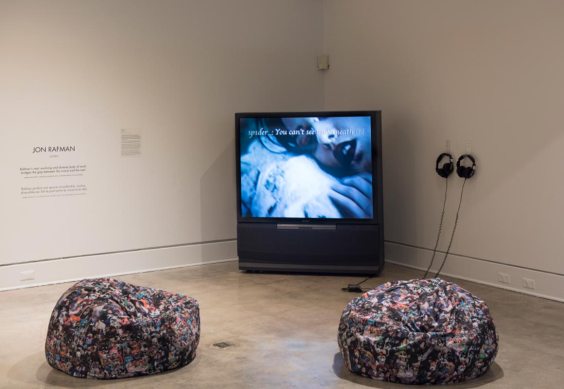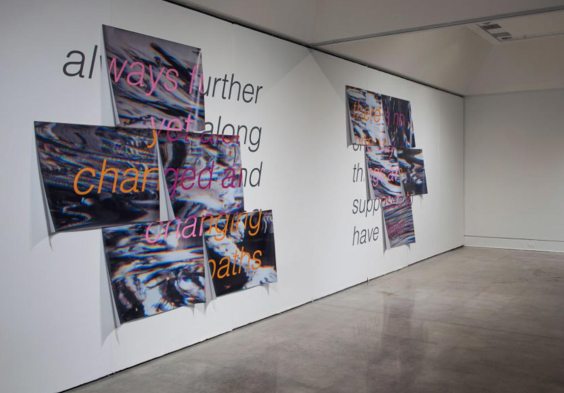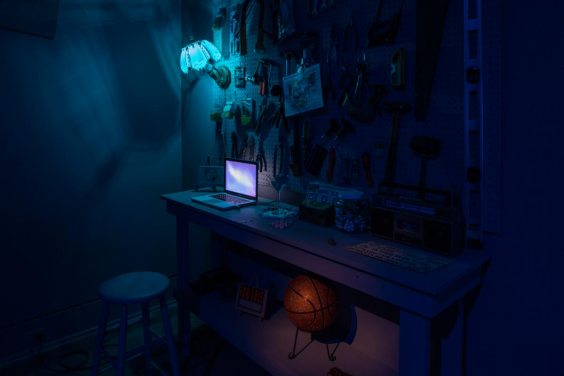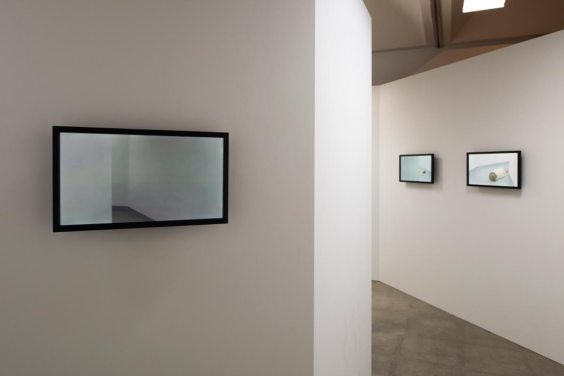The 12th exhibition of Canada’s Sobey Art Award opened last month at the Art Gallery of Nova Scotia (AGNS) in Halifax. When the winner, chosen by a jury of Canada’s top curators, is announced on 28 October, they will take home half of the $100,000 CAN total prize money. The four other finalists stand to win $10,000 each, and a further 20 long-listed artists will get $500.
The Sobey strives to be truly national in scope: the exhibition and award ceremony alternate year-to-year between the AGNS and other visual arts institutions around the country. Finalists, who must be under 40, are chosen one from each region, as are the jury.
With a gallery culture weighted towards public and other non-commercial institutions, the Canadian visual arts scene has maintained a discreet yet firm distance from the cash-flooded market culture that has so strongly influenced the international contemporary art world. In this comparatively insulated climate, the Sobey Award has become a source of valuable insight into the state of contemporary art in Canada.

Neon Parallel (1996), Jon Rafman, one of this year’s Sobey Art Award finalists. Collection of the artist. Image courtesy of the Art Gallery of Nova Scotia, photo: Steve Farmer.
What it has shown has been impressive: finalists have included artists whose work is internationally known – such as Jon Rafman (this year) and David Altmejd – as well as artists who have yet to establish a profile outside the country.
In many ways the Sobey Award can be compared with the Turner Prize – albeit a Turner Prize drawn from a population half the size of Britain’s, and distributed over a landmass roughly 40 times larger. But in others, the two prizes differ significantly. The Sobey has no broadcasting deal, and, unlike the Turner, Canada’s most important award for the visual arts generates virtually no public controversy.
As someone who rather enjoys reading the column inches devoted to debating the merits of the Turner Prize each year, coverage of the Sobey Art Award feels a bit subdued. It’s widely covered across Canada, but that coverage errs on the side of facts and introductions, generally avoiding contention.
For all that the predictable bluster around the Turner Prize has become a tired routine in Britain, as a Canadian I must confess to envying the bluster – it suggests that people care.

Versions, Versions of… (2015), Raymond Boisjoly, one of this year’s Sobey Art Award finalists. Courtesy the artist and Catriona Jeffries Gallery. Image courtesy of the Art Gallery of Nova Scotia, photo: Steve Farmer.
I spoke with Ray Cronin, the former CEO and Director of the AGNS to better understand how the award came about, and hoping to discern why wider public engagement has remained elusive. At the time of the award’s inception in 2002, Cronin was the gallery’s chief curator and was tasked with making founder Donald Sobey’s vision of a reputable contemporary art prize a reality.
‘You could spend a million dollars marketing it, and that might get the brand out there more, but it doesn’t help the artists,’ said Cronin.
‘The award’s philosophy has always been to make sure that it gets better and better for the artists.’
Touché. Broadcasting rights and light-switch scandals might work well for the Turner Prize brand and its hosts, but do those things really help the artists make more (and better) work?

Greysville (2014), Lisa Lipton, one of this year’s Sobey Art Award finalists. Collection of the artist. Image courtesy of the Art Gallery of Nova Scotia, photo: Steve Farmer.
Pressed for his opinion on why it lacks the public discourse that exists around the Turner Prize, Cronin pointed to a combination of factors.
There is, of course, Canada’s unwieldy geography – it’s faster for Londoners to fly to Halifax to see the Sobey exhibition than it is for someone from Vancouver to make the trip. That means that for most Canadians, experience of the Sobey Award comes through media coverage alone.
The lack of any high-profile visual arts critics in the two national newspapers (neither the National Post nor the Globe and Mail employ a writer dedicated to visual arts alone) means mainstream coverage is patchy, and struggles to generate the interest that an authoritative critic’s column could.
‘Who’s the person that people read to know what they should think about it?’ asks Cronin. ‘There isn’t one – there’s not one single person that you can point to.’

Hospital Hallway (2015), Sarah Anne Johnson, one of this year’s Sobey Art Award finalists. Collection of the artist. Image courtesy of the Art Gallery of Nova Scotia, photo: Steve Farmer.
Add to this the fact that the winner is chosen from the works for which the finalists were originally nominated – not the work in the resulting accompanying exhibition. With no impact on the award, the exhibition itself is unlikely to inspire impassioned debate among critics and the public.
As credible as it is lucrative, the Sobey Award has undoubtedly contributed to the development of the visual arts in Canada. Yet it feels as if few outside of the art world pay any attention, let alone have an opinion. Will the Sobey Award ever have the power to engage the average Canadian with the visual arts the way the Turner Prize stirs up Britain?
Perhaps sometimes advancing good art must be reward enough.
The Sobey Art Award Exhibition is at the Art Gallery of Nova Scotia Halifax until 3 January 2016.

The Sobey Art Award is Canada’s Turner Prize – so why does nobody know about it?
Fatigues (2014), Abbas Akhavan, one of this year's Sobey Art Award finalists. Collection of the artist. Image courtesy of the Art Gallery of Nova Scotia, photo: Steve Farmer.
Share
The 12th exhibition of Canada’s Sobey Art Award opened last month at the Art Gallery of Nova Scotia (AGNS) in Halifax. When the winner, chosen by a jury of Canada’s top curators, is announced on 28 October, they will take home half of the $100,000 CAN total prize money. The four other finalists stand to win $10,000 each, and a further 20 long-listed artists will get $500.
The Sobey strives to be truly national in scope: the exhibition and award ceremony alternate year-to-year between the AGNS and other visual arts institutions around the country. Finalists, who must be under 40, are chosen one from each region, as are the jury.
With a gallery culture weighted towards public and other non-commercial institutions, the Canadian visual arts scene has maintained a discreet yet firm distance from the cash-flooded market culture that has so strongly influenced the international contemporary art world. In this comparatively insulated climate, the Sobey Award has become a source of valuable insight into the state of contemporary art in Canada.
Neon Parallel (1996), Jon Rafman, one of this year’s Sobey Art Award finalists. Collection of the artist. Image courtesy of the Art Gallery of Nova Scotia, photo: Steve Farmer.
What it has shown has been impressive: finalists have included artists whose work is internationally known – such as Jon Rafman (this year) and David Altmejd – as well as artists who have yet to establish a profile outside the country.
In many ways the Sobey Award can be compared with the Turner Prize – albeit a Turner Prize drawn from a population half the size of Britain’s, and distributed over a landmass roughly 40 times larger. But in others, the two prizes differ significantly. The Sobey has no broadcasting deal, and, unlike the Turner, Canada’s most important award for the visual arts generates virtually no public controversy.
As someone who rather enjoys reading the column inches devoted to debating the merits of the Turner Prize each year, coverage of the Sobey Art Award feels a bit subdued. It’s widely covered across Canada, but that coverage errs on the side of facts and introductions, generally avoiding contention.
For all that the predictable bluster around the Turner Prize has become a tired routine in Britain, as a Canadian I must confess to envying the bluster – it suggests that people care.
Versions, Versions of… (2015), Raymond Boisjoly, one of this year’s Sobey Art Award finalists. Courtesy the artist and Catriona Jeffries Gallery. Image courtesy of the Art Gallery of Nova Scotia, photo: Steve Farmer.
I spoke with Ray Cronin, the former CEO and Director of the AGNS to better understand how the award came about, and hoping to discern why wider public engagement has remained elusive. At the time of the award’s inception in 2002, Cronin was the gallery’s chief curator and was tasked with making founder Donald Sobey’s vision of a reputable contemporary art prize a reality.
‘You could spend a million dollars marketing it, and that might get the brand out there more, but it doesn’t help the artists,’ said Cronin.
‘The award’s philosophy has always been to make sure that it gets better and better for the artists.’
Touché. Broadcasting rights and light-switch scandals might work well for the Turner Prize brand and its hosts, but do those things really help the artists make more (and better) work?
Greysville (2014), Lisa Lipton, one of this year’s Sobey Art Award finalists. Collection of the artist. Image courtesy of the Art Gallery of Nova Scotia, photo: Steve Farmer.
Pressed for his opinion on why it lacks the public discourse that exists around the Turner Prize, Cronin pointed to a combination of factors.
There is, of course, Canada’s unwieldy geography – it’s faster for Londoners to fly to Halifax to see the Sobey exhibition than it is for someone from Vancouver to make the trip. That means that for most Canadians, experience of the Sobey Award comes through media coverage alone.
The lack of any high-profile visual arts critics in the two national newspapers (neither the National Post nor the Globe and Mail employ a writer dedicated to visual arts alone) means mainstream coverage is patchy, and struggles to generate the interest that an authoritative critic’s column could.
‘Who’s the person that people read to know what they should think about it?’ asks Cronin. ‘There isn’t one – there’s not one single person that you can point to.’
Hospital Hallway (2015), Sarah Anne Johnson, one of this year’s Sobey Art Award finalists. Collection of the artist. Image courtesy of the Art Gallery of Nova Scotia, photo: Steve Farmer.
Add to this the fact that the winner is chosen from the works for which the finalists were originally nominated – not the work in the resulting accompanying exhibition. With no impact on the award, the exhibition itself is unlikely to inspire impassioned debate among critics and the public.
As credible as it is lucrative, the Sobey Award has undoubtedly contributed to the development of the visual arts in Canada. Yet it feels as if few outside of the art world pay any attention, let alone have an opinion. Will the Sobey Award ever have the power to engage the average Canadian with the visual arts the way the Turner Prize stirs up Britain?
Perhaps sometimes advancing good art must be reward enough.
The Sobey Art Award Exhibition is at the Art Gallery of Nova Scotia Halifax until 3 January 2016.
Unlimited access from just $16 every 3 months
Subscribe to get unlimited and exclusive access to the top art stories, interviews and exhibition reviews.
Share
Recommended for you
The Turner Prize is better off in Glasgow than London
Tramway’s a great place for it. Plus, two out of four of the exhibits are less navel-gazing than last year
Forum: Is the Turner Prize still relevant at 30?
The Turner Prize turns 30 this year – but does it continue to represent the best of contemporary British art?
Avert your Eyes: Censored Art Masterpieces
The Picasso painting censored by Fox 5 News is just the latest major artwork to be deemed indecent